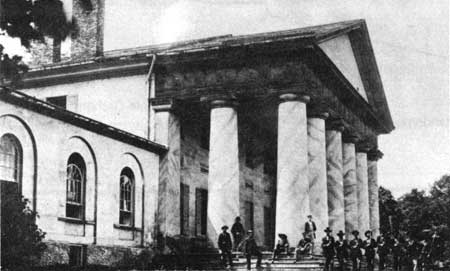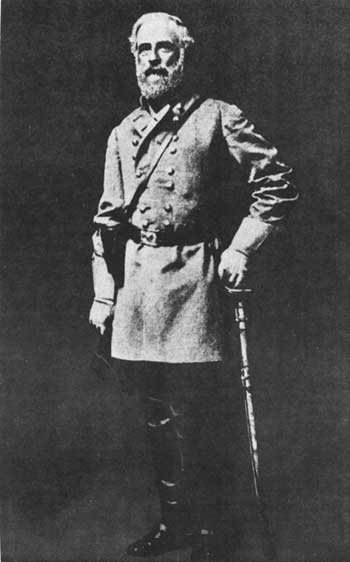|
CUSTIS-LEE MANSION The Robert E. Lee Memorial |
 |

East front of "Arlington House" in 1864.
From the photograph
by Brady in the National Archives.
Arlington from 1861 to 1865
ARLINGTON OCCUPIED BY THE FEDERAL ARMY. Mrs. Lee had been gone only a few days when the Federal Army crossed the river and occupied the heights opposite the National Capital. Overnight, what had been a quiet country estate was transformed into a vast military encampment. New roads were cut through the woods and much of it felled to open fields of fire for the earthen forts being built a short distance west of the house. Guards were posted to protect the house, and when the commanding general learned that many articles nevertheless were being stolen, he sent the Washington relics, which had been stored in the cellar, to the Patent Office for safekeeping, and then established his headquarters inside the mansion. Inevitably, the estate suffered greatly, though strong efforts were made to prevent wanton destruction, particularly of the fine old trees.

Robert E. Lee in the full dress of a Confederate
General.
From the original photograph made in 1863 by Minnis and
Cowell, Richmond. U. S. Army Signal Corps photograph.
LEE BECOMES THE HERO OF THE SOUTH. While Arlington was blighted by grim war, its former master was engaged in mobilizing the defenses of his native State. Before long he was military adviser to the President of the Confederacy, Jefferson Davis, and successively commander of the Army of Northern Virginia and general in chief of all the Confederate armies. The qualities developed by his years in the army and his home life were the same that now made him the military champion of the South and its greatest hero. His self-discipline rarely deserted him, and his deep religious beliefs gave him a humility and simplicity sufficient to withstand the greatest discouragements. Even though the odds were against him, his splendid presence on the field of battle and his kindliness and courtesy to all regardless of rank won him the devotion of his officers and men, while his brilliant military leadership gave hope and fighting spirit to the entire South. Always he was the knightly Christian gentleman, humane and magnanimous whether in victory or defeat.
THE NATIONAL CEMETERY ESTABLISHED AT ARLINGTON, 1864. Early in 1862, the army moved away from Arlington for service in the field, but the mansion continued to be used as a headquarters. In 1864, the Government levied a tax on the Arlington estate. Because Mrs. Lee was unable to appear personally to pay the tax as stipulated, payment through her agent was refused and the property sold at public auction. In June of that year the first burials were made in 200 acres set aside as a national cemetery. Work was begun at once to restore the former natural beauty of the grounds, and by the end of the war almost all the scars caused by its military occupation had been erased. Only the long rows of white headboards gleaming among the trees and the desolate house now used only for the cemetery office bespoke the bitter strife that had wrought such a profound change at Arlington.

|

| History | Links to the Past | National Park Service | Search | Contact |
|
Last Modified: Mon, Dec 2 2002 10:00:00 am PDT |

